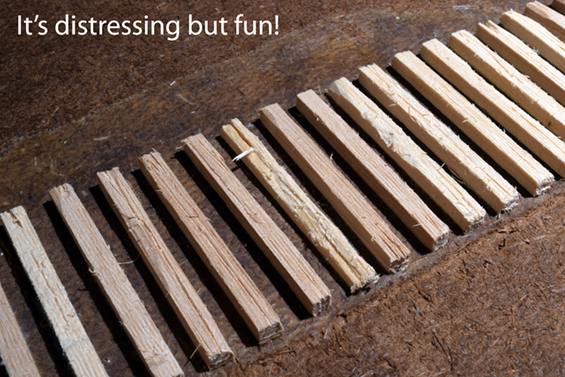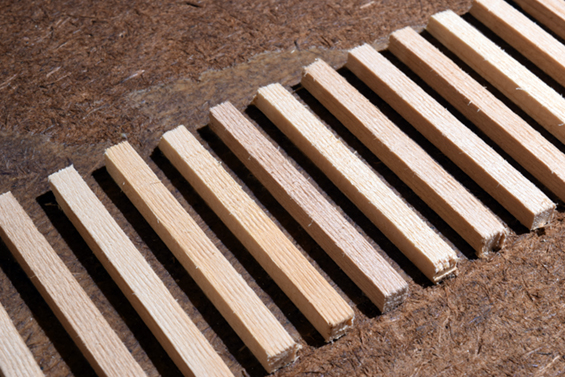I know what some might be thinking: distressing the ties on a basement sized layout to this standard would be a lifetime task that would get old quickly. I agree. However, it doesn’t have to be and there are a few considerations to keep in mind.
I enjoy this level of detail immensely, however on my own layout, I only put this amount of care into areas like the Pole Track, where a viewer can see everything close-up. I did use a razor saw blade to add a basic wood grain texture to all the ties because it would be easily seen in quarter-inch scale, even from a modest distance. I also kept the type of track in mind as I added the detailing. A lightly used branch will look different from a well maintained trunk line. For the display module’s track, I wanted a really decrepit look. Since people will be able to get an extreme close-up view, I decided to go all out on the details and texture. These photos show just a small section of a four-foot long siding.
It’s relevant to understand the importance of the modeling scale you’re working in when considering what details to add and how far to take things. Even in quarter-inch, it’s easy to go too far and turn things into a caricature. There’s a fine, easy to cross line between weathered and cartoon.
In 1:87.1 scale I wouldn’t go much farther than the wood grain effect on ties unless you’re representing a severely maintenance deferred branch. My reason is that in the smaller scale, the impression is that things are farther away, therefore the amount of visible detailing and texture will be less apparent. This is even more true for 1:160 scale. Although I’ve never had first hand experience with the scale, I could see things getting overdone quickly. In both of these scales, color and tone have a greater impact and convey a lot to the viewer when they are handled well.
Going in the opposite direction to say, 1:29 like Craig is doing, one could add even more texture to the ties because the impression in this larger scale is that you are much closer to the object and therefore able to see finer and finer details and textures. This is important to remember because we all tend to assume that what works in one scale is equally applicable to all of them. Not so.
Another lesson I’ve learned is how I tend to fall into a rhythm and begin to repeat the types and pattern of details I add. I noticed for example, all the really deteriorated ties starting looking very similar, so I took a break and let things sit for a while. Just being aware of this tendency is half the battle.
Once the ties are done it will be time for coloring, tieplates, rails and lots and lots of tiny spikes. At least I can do all that sitting down at a well lit bench.
Regards,
Mike


Wow Mike I get mentioned and I haven’t even shared with you any of the picture of my projects. 😉
But your exactly right when it comes to scale. That’s why I use tie plates, and close to scale spike heads for my track laying and even have used some 0-90 bolts for building turnout points but only in the areas of focus where the detail will stand out. On the runs between towns I’m planning on minimal detailing as you won’t be focusing on the track work, but rather the run itself.
And sometimes being and outdoor modeler I don’t have to distress/weather anything, it happens naturally over time (this can be both good and bad). When I first started building outdoors I was using a mixture of leather shoe die for tie staining, but quickly realized that it washed away with the sun bleaching. Now I’ve got a step further with dunking the ties in used motor oil. It seems to last a bit longer, but the cedar ties still need replacing after a while.
Craig
Hi Craig,
Building an outdoor layout puts you in the unique position that indoor modelers seldom or never have to deal with: your track maintenance never ends. Other than a quick cleaning after an idle period, I haven’t done anything to my track. I don’t know what climate conditions you deal with (rain, snow, cold, heat, etc.) but how long does a tie last typically?
Mike
Mike,
I live just east of Seattle, WA in the rainy pacific northwest on the Kitsap peninsula. I typically deal with rain, and standing water, and more water. I’ve found the key to keeping ties lasting longer is to have good drainage (sounds like the prototype huh?). In some spots that ties would degrade in 1-2 years, while in other spots it after 5 years the ties were still looking fairly decent. My railroad, now torn down, was on the ground so I’m hoping that the next one (in the planning stages right now) will last a bit longer because I’m planning on elevating the whole thing, and providing a different method of drainage. One of the areas that surprised my the most was a wooden trestle that was one of the first structures built. When I torn it up after 6 years, the cedar hadn’t degraded as much as I thought it would. Bout 80% of the cedar was still in good condition.
Being battery powered, the one thing I don’t have to worry about is cleaning the railheads. If I wanted maintenance free track, I would go with plastic ties, but even in the large scale they still have that plastic look that you can’t quite get rid of.
Craig
Hi Mike:
You wrote…
“Another lesson I’ve learned is how I tend to fall into a rhythm and begin to repeat the types and pattern of details I add.”
This is one of the reasons why, when I distressed the ties for my layout, I introduced a randomizer to the process. I used a 10-sided wargaming die represented on a free dice-rolling app on my phone (but one could also just use a physical die).
I’ve detailed the procedure on my blog, here:
http://themodelrailwayshow.com/cn1950s/?p=738
This helped break me away from the habit of falling into a pattern.
A great post as always – thanks for sharing!
– Trevor (Port Rowan in 1:64)
And judging by the results, it has worked well for you!
Regards,
Mike
Craig,
Would the vertical nature of the trestle be a factor in that water would shed quicker?
Mike